| The common edible fig is borne on a shrubby tree native in southwest Asia. It might have been cultivated in Jericho as early as 11,300 years ago. The tree is grown now in much of the world; it is familiar; whole books exist about it --so it is not my chosen subject this month. Instead, a small close cousin of it -- the Afghan Fig-- is featured. I choose the Afghan Fig because the World Wide Web has some suspect and conflicting claims, and I want to shed some light of truth on the matter. |
| Both these trees are members of the large genus Ficus, of some 850 species worldwide. Most are tropical or subtropical, and evergreen. More than a few bear edible fruits, but only the southwestern Asia, deciduous, relatively cold-hardy Ficus Carica is widely cultivated for fruit. |
The several deciduous fig shrubs and trees of southwest Asia are difficult to classify into species because their characteristic features blur through high variability and natural or human-caused hybridity. What to call a species, rather than a subspecies, is a judgment call. The accomplished Polish botanist Professor Kazimierz Browicz has devoted the most study to this issue, hence the classification he uses is followed wholly by me. Browicz's main writings that I consulted (and quote from) are:
|
| Flora Iranica No. 153 Moraceae (Flora des Iranischen Hochlandes und der Umbrahmenden Gebirge Persien, Afghanistan, teile von West-Pakistan, Nord-Iraq, Azerbaidjan, Turkmenistan; Printed in Austria, Akademische Druck 1982; pages 5-15. |
Chorology of Trees and Shrubs in South-west Asia and Adjacent Regions Vol. 5; Warsaw 1986; pages 23-24.
|
| What Western gardeners have been growing and selling recently under the name Ficus afghanistanica, likely consists of a blend of 1) the truely named Ficus Johannis subsp. afghanistanica, 2) cultivated varieties thereof, 3) and/or hybrids. Indeed the common fig tree itself (Ficus Carica subsp. Carica) may be a hybrid of Ficus Johannis and Ficus Carica subsp. rupestris. Genetic investigation will likely prove that most if not all plants sampled of either Ficus Johannis or Ficus Carica can be only regarded as one exceedingly variable species complex, in which case the oldest name Ficus Carica takes precedence, with Ficus Johannis a synonym. Regardless, gardeners will use whatever names they choose. |
In 1884-85 a herbarium specimen of what would be named in 1904 Ficus afghanistanica was collected by botanist James Edward Tierney Aitchison (1836-1898). In 1904 the botanist Otto Warburg (1859-1938) wrote the original (type) description of Ficus afghanistanica on page 369 of Die Gattung Ficus im nichttropischen Vorderasien (in Festschrift zur Feier des Siebzigsten Geburtstages des Herrn Professor dr. Paul Ascherson: (4. Juni 1904) verfasst von Freunden und Schülern). Warburg's Latin description cites the characteristics that makes this plant worthy of nominal recognition. Decades later Kazimierz Browicz amplified the description and classified the Afghan Fig as a subspecies of Ficus Johannis. Browicz writes:
|
| Densely branched shrub 1-3 m (4 m). Very variable leaves in both size and lobing. The subsp. afghanica has larger leaves, 7-9 (13) cm long; deeply lobed, the lobes irregularly dentate or incise-serrate, even with small second-order lobes. Some forms . . . with the largest leaves may sometimes be mistaken with the deeply lobed forms of Ficus Carica L., particularly since the two taxons hybridize in places (Turkmeniya, Iranian Khursan). It is not impossible that similarly as was the case with Ficus Carica subsp. Carica, this subspecies represents primarily cultivated forms (e.g., it is commonly cultivated in southern Tadzhikistan). |
Of the three species from the genus Ficus occurring in southwestern Asia that are deciduous, F. Carica, F. palmata and F. Johannis, the latter species is most xerophytic and covers the most dry, warm and insolated regions. It grows in fissures of various types of rocks, limestones, sandstones and vulcanic ones, on shales and conglomerates and even on gypsum, in strongly degraded open forests, on steppes and semideserts and also on edges of dried rivers and on slopes of their valleys, both in lower located places and in the mountains, more or less bewteen 500 and 2000-2200 m elevation. The lowest stands have been noted on the Iranian island Qeshm in the Arabian Gulf at 100 m elevation, and the highest ones in southern Iran in Kerman province on Kuh-i-Jupar at 2600-3000 m.
|
Typical Ficus Johannis grows between the Caspian Sea and Persian Gulf; its subspecies afghanistanica grows more to the east and northeast. Browiczw adds:
|
Because of the great variation of F. Johannis it is not surprising that several individual species have been described in the past: F. geraniifolia Miq., F. persica Boiss., F. malvastrifolia Warb., F. vitifolia Warb., and F. afghanistanica Warb. Only the last named deserves to be maintained, though only at subspecific level. Compared with subsp. Johannis it has larger leaves and figs. It appears that, as is also the case with F. Carica subsp. Carica, F. Johannis subsp. afghanistanica is a cultivated form possibly originally selected in the Kerman area of Iran. At the south limit of its range it hybridizes with with F. Carica subsp. Carica (i.e. S Turkmenia and Iranian Khorassan).
|
| My personal interest in the Afghan Fig began when I bought one from Heronswood Nursery of Kingston, Washington. It was listed in only one catalog from Heronswood (2005) as follows: "This Afghan Fig carries smaller three lobed deciduous foliage than Ficus Carica while the small figs produced are very sweet and edible. A very hardy, long-lived and drought-tolerant shrub for full sun and draining soil." For $12, I bought one in a two-inch tube. |
| Without doing any additional research I planted it in my Seattle garden, in a dry, sunny, poor-soil site at the base of a 90 foot tall Douglas Fir tree. Now, after several years of incremental growth, it is 6 inches tall and 10 inches in its widest dimension. In October 2015, it is 16 inches tall and 22 inches wide. |
This month I started reading about it on the internet. Unless I missed something, the Western commercial cultivation of what has been called --accurately or not-- the Afghan Fig is largely or wholly from this millenium. Yucca Do nursery states:
|
We got seed of this unusual fig from a customer in Atlanta, GA. He said many great things about it. "I have had the trees out for two winters and they have suffered no damage whatsoever. Although the lowest temperature we had was only 8F this year, with a late spring frost even some very hardy shrubs had tip die-back, but not these Ficus. They are deciduous, and can get to 90 feet high. They have many edible fruits and though smaller than those of Ficus Carica there are many more of them due to the size of the tree. This tree never got watered during our droughts of the last two years and it never even wilted." The seedlings have shown great vigor in our regularly watered greenhouse.
|
| Other U.S. vendors have included: Plant Delights Nursery (Raleigh, North Carolina); Forest Farm of Williams, Oregon; Glasshouse Works (calling it Iranian Fig); Cistus of Portland, Oregon has sold cultivar 'Silver Lyre'. --"entrancing, filigreed, silver-green leaves of about 5 to 7 inches." |
| Plants distributed in the United States consist both of seedlings and cuttings. According to some photos one can find on the World Wide Web, plus descriptions, there is sufficient variation that I think some specimens are hybrids. Their leaves and fruit are so much larger. The two color photos I post below show my little runt, whose largest leaf is a mere 1.5 inches long and 1 and three-eighths inches wide (In October 2015, the largest is 3 and one-eighth inches long and 3 inches wide). As quoted above, Browicz reports that the leaf length varies from 7 to 9 (13 cm) --which translates 2.75 to 3.5 (5) inches. I also reproduce a black & white scan of a black & white photo of a pressed herbarium specimen, that is printed in the aforementioned Flora Iranica No. 153 Moraceae. I used Adobe PhotoShop to touch it up a little. Note the tiny fig size. Browicz writes that the fruits of this subspecies vary from 2 to 3 (3.5 cm) in size, and their slender stems --not easily seen in the scan-- can be 2 cm (three-forths of an inch). Larger fruits and shorter stems seen on some cultivated specimens suggest hybridity with Ficus Carica. |
| Since my little plant is so slow, I think it should be moved to a rich, moist site in my garden. Then it will grow large and bear. Whoever began the assertion that the Afghan Fig tree can grow 90 feet tall in its native land, was mistaken. Maybe 9 feet --or at most meters. |
I think that the small size can be an asset, inasmuch as ordinary fig trees can grow too large and awkward to harvest. The small fruit size will not matter if the fruit is abundant, easy to pick, tasty and is less bothered by birds and other creatures. That some strains of the Afghan Fig are more cold-hardy than many or most Ficus carica will benefit certain gardeners, though to those of us in Seattle it matters not. And on a practical level it does not matter whether cultivated Afghan Fig trees are purebreds or hybrids. But people who wish precision in their labeling, and especially nurseries, ought to take careful observations and label accordingly. (Dwayne Melton e-mailed me and reported how in 2000 he imported dried fruits full of viable seeds from Tehran. He shared the seeds with various nurseries --"each fruit literally had thousands of seed and I had hundreds of fruit so had plenty to share at the time." This origin explains the enormous variation exhibited.)
Back |
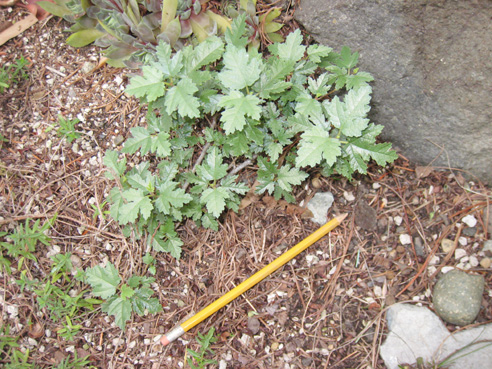
small Afghan Fig Tree (photo by ALJ)
|
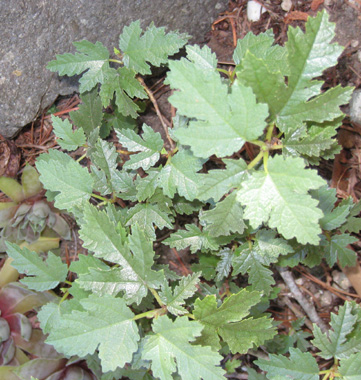
small Afghan Fig Tree close-up (photo by ALJ)
|
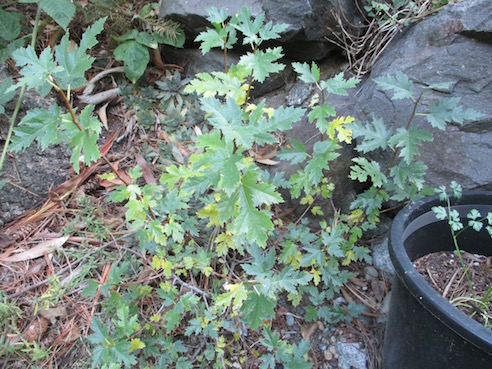
the same small Afghan Fig Tree in October 2015 (photo by ALJ)
|
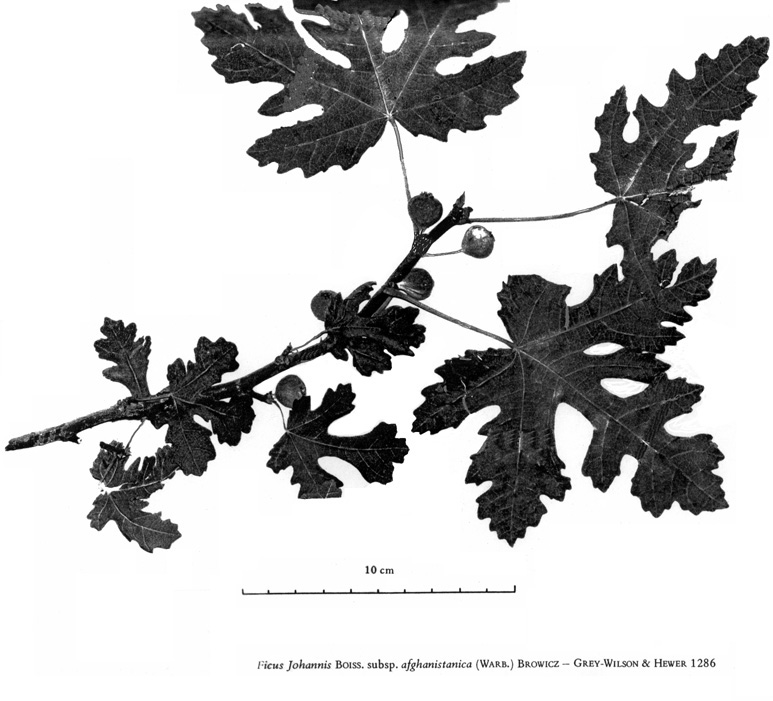
herbarium specimen of Ficus Johannis subsp. afghanistanica (scan by ALJ)
|
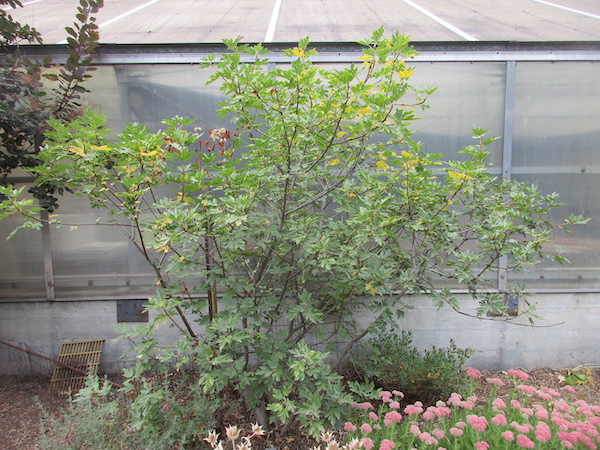
Washington Park Arboretum's Afghan Fig Tree in September 2021 (photo by ALJ)
|

